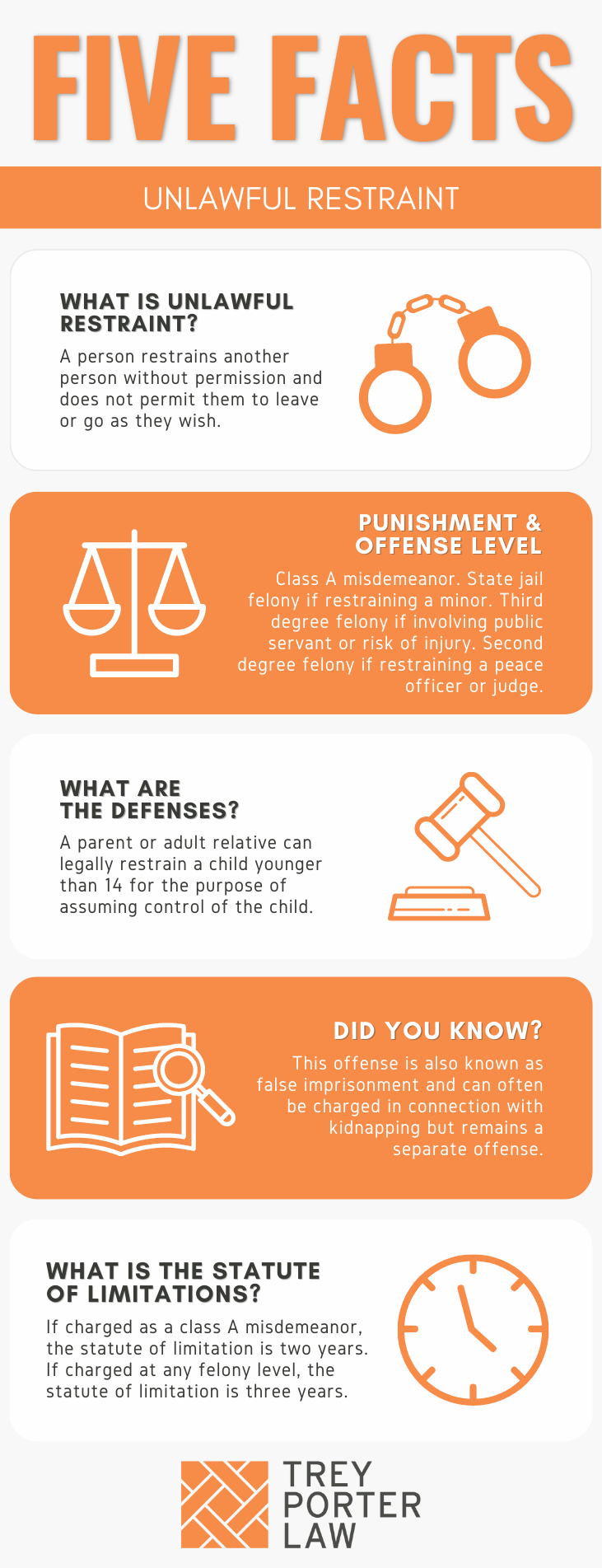WHAT IS UNLAWFUL RESTRAINT IN TEXAS?
A person who restricts another’s movement without consent commits the offense of unlawful restraint, also referred to as false imprisonment.

WHAT IS THE UNLAWFUL RESTRAINT LAW IN TEXAS?
Tex. Penal Code § 20.02. UNLAWFUL RESTRAINT.
(a) A person commits an offense if he intentionally or knowingly restrains another person.
(b) It is an affirmative defense to prosecution under this section that:
(1) the person restrained was a child younger than 14 years of age;
(2) the actor was a relative of the child; and
(3) the actor’s sole intent was to assume lawful control of the child.
(c) An offense under this section is a Class A misdemeanor, except that the offense is:
(1) a state jail felony if the person restrained was a child younger than 17 years of age;
(2) a felony of the third degree if:
(A) the actor recklessly exposes the victim to a substantial risk of serious bodily injury;
(B) the actor restrains an individual the actor knows is a public servant while the public servant is lawfully discharging an official duty or in retaliation or on account of an exercise of official power or performance of an official duty as a public servant; or
(C) the actor while in custody restrains any other person; or
(3) notwithstanding Subdivision (2)(B), a felony of the second degree if the actor restrains an individual the actor knows is a peace officer or judge while the officer or judge is lawfully discharging an official duty or in retaliation or on account of an exercise of official power or performance of an official duty as a peace officer or judge.
(d) It is no offense to detain or move another under this section when it is for the purpose of effecting a lawful arrest or detaining an individual lawfully arrested.
(e) It is an affirmative defense to prosecution under this section that:
(1) the person restrained was a child who is 14 years of age or older and younger than 17 years of age;
(2) the actor does not restrain the child by force, intimidation, or deception; and
(3) the actor is not more than three years older than the child.
WHAT IS THE PENALTY CLASS FOR UNLAWFUL RESTRAINT IN TEXAS?
The penalty classification for unlawful restraint begins at a Class A misdemeanor, punishable by up to one year in county jail, and is enhanced depending on the severity of the conduct:
- State jail felony, punishable by 180 days to two years in a state jail facility, if:
- the victim is younger than 17 years;
- Third degree felony, punishable by two to ten years in prison, if:
- the victim is exposed to a substantial risk of serious bodily injury;
- the person restrains a public servant lawfully discharging an official duty, or in retaliation for or on account of the public servant’s exercise of an official duty; or
- the person restrains another while in custody;
- Second degree felony, punishable by two to 20 years in prison, if:
- the person restrains a peace officer lawfully discharging an official duty, or in retaliation for or on account of the peace officer’s exercise of an official duty.
WHAT IS THE PUNISHMENT RANGE FOR UNLAWFUL RESTRAINT IN TEXAS?
A person charged with unlawful restraint faces anywhere from a year in county jail to 20 years in prison, depending on the penalty classification of the offense.
- Without any other aggravating factors, unlawful restraint is a Class A misdemeanor, with a maximum jail sentence of one year, and up to a $4,000 fine.
- If the victim was under 17 years of age, unlawful restraint is a state jail felony, which carries between 180 days and two years in a state jail facility, and a maximum fine of $10,000.
- If the victim was a public servant lawfully discharging an official duty, the victim was exposed to a substantial risk of serious bodily injury, or the person restrained another while in custody:
- Third degree felony, with a punishment range of two to ten years in prison, and a maximum fine of $10,000.
- If the victim was a peace officer lawfully discharging an official duty, or the restraint was due to the peace officer’s official status or service:
- Second degree felony, with a punishment range of two to 20 years in prison, and a maximum fine of $10,000.
WHAT ARE THE PENALTIES FOR UNLAWFUL RESTRAINT IN TEXAS?
A person charged with unlawful restraint may be eligible for probation after a conviction, or deferred adjudication without a conviction. The minimum and maximum periods of supervision vary, depending on the offense category:
- Class A misdemeanor: maximum supervision term of two years;
- State jail felony: community supervision term between two and five years;
- Third degree and second degree felonies: community supervision term between two and ten years.
WHAT ARE THE DEFENSES TO UNLAWFUL RESTRAINT IN TEXAS?
The statute advises “[i]t is no offense” for a peace officer to lawfully detain or arrest someone. It also creates an affirmative defense for an accused who is 19 years old or younger, and restrains a child between ages 14 and 16 without using force, intimidation, or deception.
- Can a parent unlawfully restrain his or her own child in Texas? If a parent or other relative of a child younger than 14 restrains the child for the sole purpose of gaining lawful control, it is an affirmative defense to an unlawful restraint charge. Parents are not often charged with unlawful restraint, given the multitude of laws protecting the parent-child relationship.The Texas Penal Code permits parents to use reasonable and necessary force to discipline their children, and the Texas Family Code likewise permits a parent to use corporal punishment as reasonable discipline.
WHAT IS THE STATUTE OF LIMITATIONS FOR UNLAWFUL RESTRAINT IN TEXAS?
The limitation period for Class A misdemeanor unlawful restraint is two years. The limitation period for unlawful restraint categorized as a state jail felony, third degree, and second degree felony is three years.
UNLAWFUL RESTRAINT IN TEXAS
The law against unlawful restraint, or false imprisonment, prohibits the intentional or knowing restriction of another’s movement without consent, whether by force, intimidation, deception, or any other means.
TEXAS UNLAWFUL RESTRAINT COURT CASES
The case law regarding unlawful restraint in Texas demonstrates the various ways in which the crime is committed.
- In Walton v. State, a defendant asked his girlfriend, the victim, to get into his truck to talk. He sped off once she got in, and despite the victim’s repeated requests to stop and let her out, he refused. Instead, he told her they were going to die. The defendant was speeding, swerving in and out of traffic, and nearly sideswiped one driver. The defendant was convicted of unlawful restraint by recklessly exposing the victim to a substantial risk of serious bodily injury, a third degree felony, and the appellate court affirmed. Walton v. State, 641 S.W.3d 861 (Tex. App.—Fort Worth 2022, pet. ref’d) abrogated on other grounds by Anastassov v. State, No. PD-0848-20 (Tex. Crim. App. Oct. 5, 2022).
- In Smitherman v. State, the defendant was a long-time friend of the 13-year-old victim’s family. He followed her into an RV on their property, and started saying vulgar and sexual things. When she got up to leave, he grabbed her arm, and told her he would tell her mother he saw her with a vape pen three days earlier if she left. Not wanting to get in trouble, she sat back down. When he eventually grabbed her face, she punched him, yelled at him, and he left. He was convicted of state jail felony unlawful restraint, and the appellate court affirmed. His restraint was without the victim’s consent because it was by intimidation. No. 05-21-00196-CR (Tex. App.—Dallas June 10, 2022, no pet.).
- In Smith v. State, another defendant was convicted of Class A misdemeanor unlawful restraint against his ex-fiancee after dragging her into her apartment and assaulting her. He grabbed her keys, refused to allow her to leave, and choked her. She was eventually able to leave, and went to the police station. The appellate court upheld the defendant’s convictions for assault and unlawful restraint. Smith v. State, No 02-21-00201-CR (Tex. App.—Fort Worth July 28, 2022, no pet.).
















